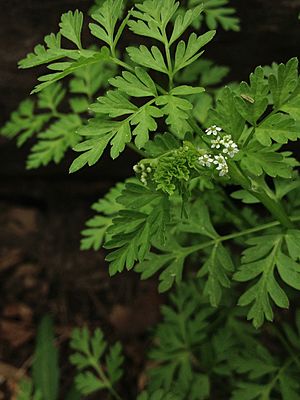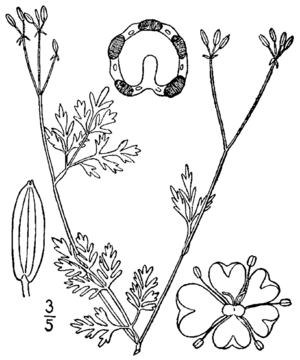Spreading chervil facts for kids
Quick facts for kids Spreading chervil |
|
|---|---|
 |
|
| Scientific classification | |
| Genus: |
Chaerophyllum
|
| Species: |
procumbens
|
| Synonyms | |
|
Chaerophyllum articulatum Bosc ex DC. |
|
Chaerophyllum procumbens, also called spreading chervil or wild chervil, is a plant that lives for only one year. It grows naturally in the eastern parts of the United States and Canada. This plant is known for its small white flowers that bloom in the springtime.
What Does Spreading Chervil Look Like?
Spreading chervil plants usually grow to be about 15 to 50 centimeters tall. That's like the length of a ruler or a bit more!
The plant has several thin stems that branch out from its base. These stems look shiny. They also have a line of tiny hairs running along them.
The leaves are mostly smooth, without much hair. They are shaped like triangles. Each leaf is made up of smaller leaflets. These smaller parts are also divided into even tinier sections.
- The leaves lower down on the plant have small stalks called petioles.
- The leaves higher up are smaller and grow very close to the main stem.
At the top of the stems, you'll find groups of small white flowers. These groups are called umbels. Each main group has about 2 to 6 smaller groups of flowers. Each of these smaller groups has 1 to 7 tiny white flowers. Each flower has 5 petals.
Sometimes, the flowers start to open even before the whole flower cluster has fully spread out. After the flowers, the plant makes a fruit. This fruit is a long, oval-shaped capsule. It is about 4 to 6 millimeters long and has ridges running down its sides.
Where Does Spreading Chervil Grow?
Spreading chervil is found across the eastern United States. It also grows in the Canadian province of Ontario. While it's widespread, you might not find it everywhere in these areas. Its presence can be a bit patchy.
This plant has been seen in many states, including:
- Alabama
- Arkansas
- Delaware
- Florida
- Georgia
- Illinois
- Indiana
- Iowa
- Kansas
- Kentucky
- Maryland
- Michigan
- Mississippi
- Missouri
- Nebraska
- New Jersey
- New York
- North Carolina
- Ohio
- Oklahoma
- Pennsylvania
- South Carolina
- Tennessee
- Virginia
- Washington, D.C.
- West Virginia
- Wisconsin
In New York state, spreading chervil is listed as an endangered species. This means it's a plant that is at risk of disappearing completely.
In places like Virginia, it likes to grow in forests near rivers. It also grows in open areas that are often flooded by rivers.
For this plant to survive, it needs the right kind of habitat. Its home can be destroyed by new buildings or changes in how land is used. It can also be harmed by invasive species. These are plants that are not native to the area and can take over, pushing out the native plants.


